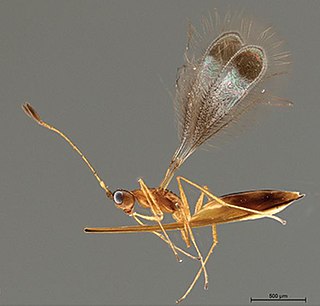
Apocrita is a suborder of insects in the order Hymenoptera. It includes wasps, bees, and ants, and consists of many families. It contains the most advanced hymenopterans and is distinguished from Symphyta by the narrow "waist" (petiole) formed between the first two segments of the actual abdomen; the first abdominal segment is fused to the thorax, and is called the propodeum. Therefore, it is general practice, when discussing the body of an apocritan in a technical sense, to refer to the mesosoma and metasoma rather than the "thorax" and "abdomen", respectively. The evolution of a constricted waist was an important adaption for the parasitoid lifestyle of the ancestral apocritan, allowing more maneuverability of the female's ovipositor. The ovipositor either extends freely or is retracted, and may be developed into a stinger for both defense and paralyzing prey. Larvae are legless and blind, and either feed inside a host or in a nest cell provisioned by their mothers.

Treehoppers and thorn bugs are members of the family Membracidae, a group of insects related to the cicadas and the leafhoppers. About 3,200 species of treehoppers in over 400 genera are known. They are found on all continents except Antarctica; only five species are known from Europe. Individual treehoppers usually live for only a few months.

The Mymaridae, commonly known as fairyflies or fairy wasps, are a family of chalcidoid wasps found in temperate, subtropical, and tropical regions throughout the world. The family contains around 100 genera with 1,400 species.

The Mymarommatidae, sometimes referred to as false fairy wasps, are a very small family of microscopic parasitic wasps. Only about half of the known species are living taxa, but they are found worldwide.

Dicopomorpha echmepterygis is the smallest known insect and a species of parasitoid wasp of the family Mymaridae, which exhibits strong sexual dimorphism. The males are blind, apterous, and their body length is only 40% that of females. With a body length averaging 186 μm, males of D. echmepterygis have the shortest body length of all known insects. The measured body length of a female was 550 μm. Dicopomorpha echmepterygis males have relatively long legs and are dull grayish brown, with small heads that lack compound eyes, and unsegmented antennae. Females, however, have entirely black bodies with dusky brown legs and antennae. The antennae are twice as long as for males, and females have fully-functional wings that are narrowed slightly through the middle. The eggs and larvae of this parasitoid are considerably smaller than the adult.

A wasp is any insect of the narrow-waisted suborder Apocrita of the order Hymenoptera which is neither a bee nor an ant; this excludes the broad-waisted sawflies (Symphyta), which look somewhat like wasps, but are in a separate suborder. The wasps do not constitute a clade, a complete natural group with a single ancestor, as bees and ants are deeply nested within the wasps, having evolved from wasp ancestors. Wasps that are members of the clade Aculeata can sting their prey.

Anagyrus is a large genus of parasitic wasps from the family Encyrtidae. Anagyrus is distributed throughout the world. A subgenus of Anagyrus is known as Nesoanagyrus

Myanmymar is an extinct genus of fairyfly preserved in Burmese amber from Myanmar. It has only one species, Myanmymar aresconoides. It is dated to the earliest part of the Cenomanian stage of the Late Cretaceous, around 99 million years old. As of 2011, it is the oldest known fossil mymarid.

Kikiki is a genus of fairyfly wasps containing a single species, Kikiki huna, known from Hawaii, Costa Rica, Nagarcoil and Trinidad. At 0.15 mm (0.0059 in), it is the smallest flying insect known as of 2019. It is a close relative of wasps in the genus Tinkerbella. It was discovered in the Hawaiian Islands by John T. Huber and John W. Beardsley, and published in 2000. The name Kikiki huna consists of two Hawaiian words that both carry the meaning 'tiny bit'.
Rotoita basalis is a small parasitic wasp in the relictual family Rotoitidae. It is known only from New Zealand, and its closest known living relative is endemic to Chile.

Leipomeles dorsata is a neotropical paper wasp that is found across Central America and northern South America. It is a eusocial wasp with little differentiation between reproducing and non-reproducing females. In fact, workers can become temporary reproductives if the main reproductives are killed, allowing reproduction to continue until the main reproductive population recovers. The colony cycles through different ratios of main reproductive females and subordinate reproductive females, starting with few or no primary reproducing females, and increasing until there are only main reproductives.
Anaphes nitens is a species of fairyfly, a chalcid wasp in the family Mymaridae. Native to Australia, it is an egg parasitoid of the gum tree snout beetle, a pest of Eucalyptus trees, and has been used in biological pest control of that species.

Polynema is a genus of fairyflies or fairy wasps, insects in the family Mymaridae.
John Stuart Noyes is a Welsh entomologist.

Sclerodermus domesticus, also known as Scleroderma domesticus, Scleroderma domesticum, Scleroderma domestica or "antiquarian's friend", is a species of cuckoo wasp in the insect genus Sclerodermus. It was first described by Pierre André Latreille in 1809.

Gonatocerus is a genus of fairyflies in the family Mymaridae. There are at least 260 described species in Gonatocerus.
Cochlodispus minimus is a species of mite from the family Microdispidae, formally described by Sándor Mahunka in 1976. One adult individual was measured with a body length of 79 μm, making it the smallest known mite species. It was originally described from Ethiopia, along with cogeners C. africanus and C. fimbrisetus, and inhabits soil and litter.
Cochlodispus is a genus of mites from the family Microdispidae. One member of the genus, Cochlodispus minimus, is considered the smallest known mite species with a recorded adult body length of 79 μm.













